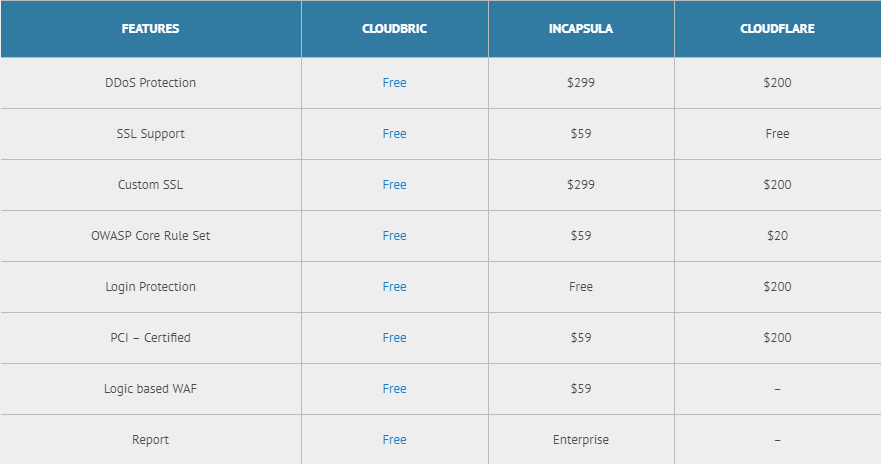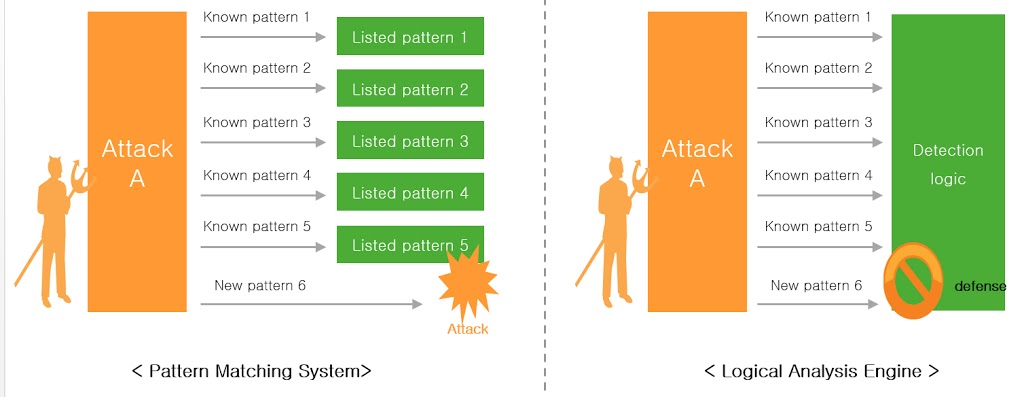Cloudbric received a lot of questions about our web application security service, and in our mission to democratize cyber security, we try our best to make the information readily available. We post a lot of answers in our Help Center, but every week we will give a longer answer about one question. This week, a user asks…
How Does Cloudbric Stack Up to Cloudflare and Incapsula?
If you know what a web application firewall (WAF) is or needed to install one in your website, you’ve probably heard a few of the WAF names out there. But what sets them apart from each other, and what is the distinct character of each? If you’re going to be trusting your website to one of these WAFs, which one is right for you?
Two of the big names in this rapidly growing market are Incapsula and Cloudflare, both of which provide fine enterprise-level protection, available at enterprise-level prices. Cloudbric, in comparison, has a much different approach to providing web application security. Let’s look at some of the key differences.
1. Payment

Both Incapsula and Cloudflare have free plans, and Incapsula has trial periods for its Business (7 days) and Pro (14 days) plans.
Cloudbric, however, has no free trial. That’s because it’s always free to sign up for Cloudbric, and you won’t have to pay a cent to get started.
While Incapsula and Cloudflare offer multiple payment plans ranging from Enterprise, Business, and Pro to Free, Cloudbric only has the one plan. You pay for traffic size rather than number of features, opening up our comprehensive protection to all websites, no matter how small. Why should a starting business have to pay as much as a giant corporation for security features if it doesn’t have enough customers yet? If you start doing more business, only then does Cloudbric begin charging you, once you can afford it. That’s how Cloudbric supports newly started websites and businesses that can’t afford expensive security features.
2. Comprehensiveness
Need protection from layer 3, 4, or 7 DDoS attack? That’s $20 a month from Cloudflare, or $299 a month from Incapsula. Cloudbric provides this for free, because DDoS attacks don’t discriminate by website traffic. If you run a small website, you need advanced DDoS protection just as much as the big sites, maybe more.
Cloudbric’s pricing scheme ensures that you receive all security features, starting on day 1. If you want to keep it free, Incapsula and Cloudflare certainly offer free plans, but with limited features.
Additionally, Cloudbric offers a PCI-certified WAF, web optimization, OWASP core rule set, login protection, and several other features entirely free, whereas the other two will make you pay for all these things. Cloudbric is the only web app security option that gives you access to all features without having to pay a cent.
3. Logic Analysis Engine

The three web app services also offer differing levels of performance, run on entirely different engines.
Imperva uses a pattern-matching engine that logs prior malicious traffic and creates a blacklist for them. This means that it may not be the best protection against the latest threats.
Cloudflare’s engine operates a similar manner. Theirs is based on ModSecurity, an open-source WAF engine, and if you think it’s a little strange to base security features on open-source code, you’re in good company.
Rather than relying on pattern matching of prior malicious activity, Cloudbric uses its own logic analysis engine developed by Penta Security, capable of predicting new patterns of attack based on identifying suspicious behavior. This engine uses 26 search parameters to monitor your traffic and block threats. This process only takes 1/1,000 of a second.
The effectiveness of Cloudbric’s protection is superior, as found in a study by the Tolly Group, an independent test lab.
Conclusion
Through its fair pricing system, comprehensive coverage, and superior technology, Cloudbric is able to run circles around the competition. Cloudbric is a service that prioritizes small businesses, democratizing web application security. It is available for people who can’t afford fancy security packages, who pay proportionally less than larger businesses. By making its protection services available based on bandwidth size, it fills large holes in web security that Cloudflare and Incapsula can’t reach, ensuring website protection for all.





